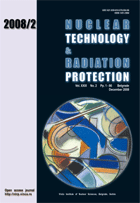
MTR CORE LOADING PATTERN OPTIMIZATION USING BURNUP DEPENDENT GROUP CONSTANTS

Vol. XXIII, No. 2, Pp. 1-86
December 2008
UDC 621.039+614.876:504.06
ISSN 1451-3994
....Back to Contents
Pages: 28-33
Authors: Masood Iqbal, Sikander M. Mirza, Mohsin S. Ali
Abstract
A diffusion theory based MTR fuel management methodology has been developed for finding superior core loading patterns at any stage for MTR systems, keeping track of burnup of individual fuel assemblies throughout their history. It is based on using burnup dependent group constants obtained by the WIMS-D/4 computer code for standard fuel elements and control fuel elements. This methodology has been implemented in a computer program named BFMTR, which carries out detailed five group diffusion theory calculations using the CITATION code as a subroutine. The core-wide spatial flux and power profiles thus obtained are used for calculating the peak-to-average power- and flux-ratios along with the available excess reactivity of the system. The fuel manager can use the BFMTR code for loading pattern optimization for maximizing the excess reactivity, keeping the peak-to-average power as well as flux-ratio within constraints. The results obtained by the BFMTR code have been found to be in good agreement with the corresponding experimental values for the equilibrium core of the Pakistan Research Reactor-1.
Key words: MTR, fuel burnup, core loading, core management, optimization, PARR-1
FULL PAPER IN PDF FORMAT (860 KB)
Last updated on September, 2010